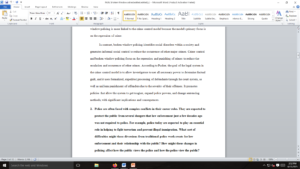Models of criminal process
Each response will require approximately 1.5 pages. Be sure to use citation where appropriate.
- Describe in detail the central thesis behind Broken Windows policing. How does Broken Windows fit into Packer’s two models of criminal process? That is, is Broken Windows more closely linked to Crime Control or Due Process? What implications does this have and what might Packer suggest are some of the consequences of this approach?
- Police are often faced with difficult conflicts in their career roles. They are expected to protect the public from a number of dangers that law enforcement just a few decades ago were not asked to police. For example, police today are expected to play an important role in helping to fight terrorism and prevent illegal immigration. What sort of difficulties might these diversions from traditional police work create for law enforcement and their relationship with the public? How might these changes in policing affect how the public views the police and affect how the police view the public?
- Tyler discusses the importance of legitimacy for developing support and cooperation with police. In the changing face of policing, specifically as law enforcement has become more militarized, how might willful cooperation and support of the police change? What effects might the militarization of the police have on the public’s view of police as legitimate?
- When detailing the policeman’s lot, Reiss describes the steps an officer must go through in detailing the “plot” of a situation. Describe these different steps and how they have changed and their relevance since Reiss’s writing.
- What role might racial disparities in the criminal justice system, especially in policing, and the war on crime have on promoting the support and cooperation of the public with police? What policies may be effective in helping to ameliorate any problems that might exist?
- Reiss describes the importance of reciprocity in the relationship between the police and the public. What can happen when this breaks down? Describe some recent examples of this decline in reciprocity and what could be done to ensure that it does not completely erode.
Requirements: 1.5 Pages per question | .doc file
Answer preview
marginalized and disadvantaged groups will have no access to safety, increasing the crime rates within the community (Cole and Gertz, 2012). It is a significant challenge as there would be underfunding policing for the poor populations while the more responsive policing for the affluent communities. It creates a considerable inequality to access safety, impacting the wellbeing of a community and contributing to more crime, in the case of immigration, either legal or illegal immigration. Until recently, most police agencies in the United States believed that executing immigration laws was a federal rather than a municipal job. The police wanted immigrants to feel free to approach the police if victims of crime, especially when employers exploited them. Even persons who were in the nation unlawfully deserved to be protected by the law, according to police officials. However, in response to rising anti-illegal immigration sentiments, police forces have begun to enforce immigration laws (Reiss, 1973). As expected, this has alienated these communities when connecting with immigrants is more important as they form a significant part of the United States population and society.
[3186 Words]

Models of criminal process

